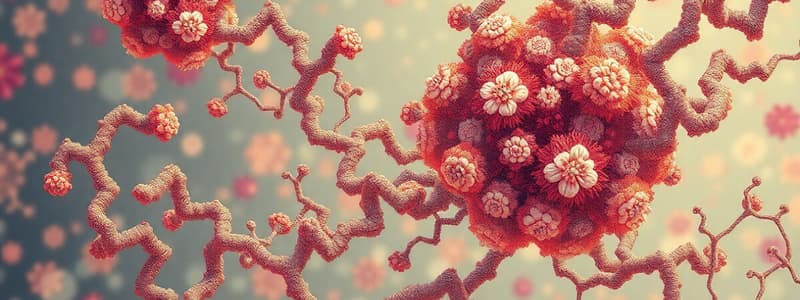Podcast
Questions and Answers
What describes the general structure of an amino acid?
What describes the general structure of an amino acid?
- Two carbon atoms, one part of a carboxylic acid group and one with an amine group. (correct)
- Four carbon atoms, each bonded to a nitrogen atom.
- Three carbon atoms, all part of a ketone structure.
- One carbon atom attached to two amine groups.
What type of bond links two amino acids together?
What type of bond links two amino acids together?
- Peptide bond (correct)
- Covalent bond
- Ionic bond
- Hydrogen bond
Which statement about protein structure is true?
Which statement about protein structure is true?
- Secondary structure pertains only to disulphide bridges.
- Quaternary structure involves multiple polypeptide chains. (correct)
- The primary structure includes covalent disulphide bonds.
- The tertiary structure refers specifically to the sequence of amino acids.
What is the N-terminus in a peptide sequence?
What is the N-terminus in a peptide sequence?
Why is the 3D structure of proteins important?
Why is the 3D structure of proteins important?
What is the primary importance of a protein's three-dimensional structure?
What is the primary importance of a protein's three-dimensional structure?
Which types of interactions contribute to the stabilization of tertiary structure in proteins?
Which types of interactions contribute to the stabilization of tertiary structure in proteins?
What depicts the structure of an alpha-helix in protein representation?
What depicts the structure of an alpha-helix in protein representation?
What is the basic feature of a beta-sheet in protein structure?
What is the basic feature of a beta-sheet in protein structure?
Which amino acids are typically involved in hydrophobic interactions relevant to tertiary protein structure?
Which amino acids are typically involved in hydrophobic interactions relevant to tertiary protein structure?
Flashcards
Protein Structure
Protein Structure
The three-dimensional arrangement of amino acids within a protein.
Secondary Structure
Secondary Structure
Regular, repeating patterns of amino acids in a protein chain, stabilized by hydrogen bonds.
Tertiary Structure
Tertiary Structure
The overall, 3D shape of a single protein.
Protein Folding
Protein Folding
Signup and view all the flashcards
Interactions Stabilizing Tertiary Structure
Interactions Stabilizing Tertiary Structure
Signup and view all the flashcards
Amino Acid Structure
Amino Acid Structure
Signup and view all the flashcards
Peptide Bond
Peptide Bond
Signup and view all the flashcards
Primary Protein Structure
Primary Protein Structure
Signup and view all the flashcards
Protein Secondary Structure
Protein Secondary Structure
Signup and view all the flashcards
Protein Tertiary Structure
Protein Tertiary Structure
Signup and view all the flashcards
Study Notes
Biochemistry - Amino Acids & Protein Function
- Learning Outcomes:
- Understand the general structure of amino acids.
- Learn how amino acids link to form peptide bonds.
- Understand primary, secondary, tertiary, and quaternary protein structures, including common secondary structures.
- Appreciate the importance of protein 3D structure in biological function.
Amino Acid Structure
- Amino acids have a general structure with two carbon atoms: one part of a carboxylic acid group, the other with an amine group.
- A central α-carbon atom.
- An amine group (NH₂).
- A carboxyl group (COOH).
- A variable R-group (R).
Amino Acids & Protein Synthesis
- There are numerous possible amino acids, but only 20 are genetically encoded and used in protein synthesis.
- Specific amino acid sequences are crucial for unique protein functions.
Protein Structure Levels
- Primary Structure: The sequence of amino acids linked by peptide bonds.
- The order of amino acids dictates the protein's unique properties.
- Secondary Structure: Localized folding patterns (e.g., α-helix, β-sheet) of the polypeptide chain created by hydrogen bonds.
- α-helix is a coiled structure.
- β-sheet is a sheet-like structure; parallel or anti-parallel.
- Tertiary Structure: The 3D folding of the entire polypeptide chain.
- Stabilized by various interactions between amino acid side chains (R-groups): hydrogen bonds, hydrophobic interactions, electrostatic interactions.
- Quaternary Structure: The combination of multiple polypeptide chains to form a functional protein complex.
- Stabilized by interactions between the different polypeptide chains.
Protein Folding & Function
- A protein's 3D structure is fundamental to its function.
- Correct folding is crucial.
- The amino acid sequence determines the protein's 3D structure.
- Incorrect folding can lead to loss of function or disease.
Enzyme Mechanism
- Enzymes (like chymotrypsin) catalyse reactions by binding to substrates in their active sites.
- 3D structure is vital for the precise shape of the active site.
- A catalytic triad of amino acids in the active site of chymotrypsin is crucial for the enzyme’s catalytic activity.
- The amino acid residues are spatially close together in the tertiary structured form.
Disulfide Bonds
- Covalent disulfide bonds form between cysteine residues.
- Located in the primary protein structure.
- They can influence protein’s 3D structure (stability of tertiary structure), strengthening the polypeptide chains or protein complexes.
Studying That Suits You
Use AI to generate personalized quizzes and flashcards to suit your learning preferences.




